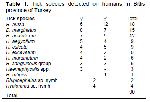In Turkey some studies have been conducted on tick
infestation on humans. As a result of these studies; in
Thrace province: H. marginatum, H. aegyptium, H.
detritum, Ixodes ricinus R. sanguineus group, R. bursa,
Haemaphysalis parva, Haemaphysalis punctata, H.
sulcata, D. marginatus, Ornithodoros sp. and Argas sp.
10; in Istanbul province: I. ricinus, H. marginatum, H.
aegyptium, H. detritum, R. bursa, R. sanguineus and D.
marginatus
11; in central Black Sea region: H.
marginatum, H. detritum, H. excavatum, H. anatolicum,
R. bursa, Rhipicephalus turanicus, D. marginatus, I.
ricinus and H. punctata
12; in Aydın province: H.
aegyptium, H. anatolicum, Hyalomma scupense, H.
excavatum, H. marginatum, H. rufipes, Rhipicephalus
(Boophilus) annulatus, R. bursa, R.sanguineus,
R.turanicus, D. marginatus, I. ricinus and H. parva were
determined
13. Our results consistent with the previous
studies and also these results are the first record for tick
species in Bitlis province.
In Turkey 7 Hyalomma species [H. anatolicum, H.
excavatum, H. marginatum, H. detritum, Hyalomma dromedarii, H. rufipes, and H. aegyptium] have been
recorded5,14. However, the presence of H. rufipes
has only been recorded rarely in Turkey, in Eastern
Anatolia15. Recently, H. rufipes was detected on cattle
in the West Aegean and South Marmara region16,17
and on human in Aydın province of Turkey13.
Hyalomma rufipes transmit a variety of protozoal,
bacterial and viral agents, such as the CCHF virus,
Anaplasma marginale, Rickettsia conorii, and Babesia
occultans8.
In conclusion, this is a preliminary data reported for
tick species for humans in the Bitlis province. These
results are the first data for tick species in the province.
Further studies are warranted for ticks and people should
be trained about ticks and tick-borne diseases in the
province and thorough the Turkey.
Acknowledgement
We thank all the health workers and the staff of the
Emergency Service and Microbiology Laboratory of Bitlis
State Hospital.





